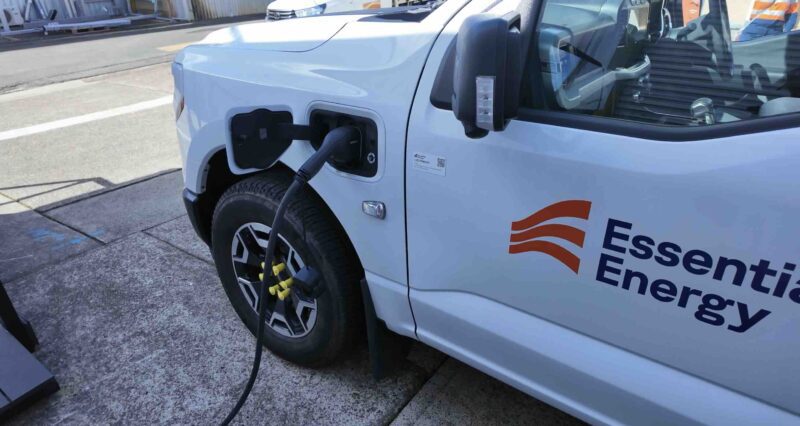One of Australia’s largest electricity distributors, Essential Energy, says vehicle-to-grid technology will be soon be available on its vast network for most EVs models after a successful trial involving a Ford Lightning electric ute and technology company Sigenergy.
V2G is anticipated to be the next big thing in the transition to EVs – enabling electric vehicle owners to use their vehicles as batteries on wheels, and providing valuable resources for grid management, helping to fill in supply gaps, respond to grid disruptions, lower prices for all and make money for EV owners.
So far the technology has been available only to the Nissan Leaf and Mitsubishi Outlander plug in hybrid that both operate on the old CHAdeMO charging protocol. Now it is being introduced for CCS2, the new charging protocol that is used by all modern EVs.
The trial involved Essential Energy, whose network covers most of NSW outside Sydney, Newcastle and Wollongong, along with the CSIRO, and AusEV, which distributes the Ford Lightning F-150 electric ute in Australia.
Essential chief operating officer Luke Jenner says the success of the trial is a huge step forward in enabling the energy transition. “It’s trialled, it’s tested and it’s ready,” Luke Jenner said.
The company had been trialling V2G technology since 2023 with a Nissand Leaf and a Wallbox Quasar charger at a farm near Goulburn, and more recently established a test centre at Port Macquarie, where the Ford Lightning – which had been bought as a work ute – was tested.
“Last year, we started working with CSIRO on an additional trial at our Innovation Hub in Port Macquarie and recent tests have confirmed that the Sigenergy SigenStor CCS2 DC bi-directional charger and the AusEV Ford F-150 Lightning work effectively on our network.”
While the initial tests have been on the F-150 Lightning, which features a very large 131 kWh battery, Essential says it is now applicable to other EVs and they are investigating V2G opportunities with other car manufacturers. “This is a huge step forward for EV owners,” he says, adding that trials have begun with 15 different EV models.
“It unlocks immense potential by providing additional support for the grid and the management of the power system, and will provide benefits whether or not people have EVs or not.”
The Sigenergy SigenStor energy storage system, which has an integrated V2G charger that has been approved by the Clean Energy Council, can be installed on the Essential Energy network through the existing solar connection process.
Sigenergy CEO Will Hall tests are being conducted with innovative electricity provider Amber, which could lead to potentially lucrative revenue streams for EV owners.
Hall says tests have been conducted with a number of different car manufacturers overseas, and said the completion of the first trial in Australia is significant. “Hopefully it will open up the floodgates,” he said.
The Sigenergy V2G component is part of a “five-in-one” DC-couple battery pack, that includes a minimum 8 kWh battery (and can be grown in 8 kWh increments). The base pack would cost around $15,000 to $20,000, but will likely be eligible for a $3,000 discount under the federal government’s newly Cheaper Battery program.
The involvement with the CSIRO is focused on how the technology is absorbed into the home electricity management system, and into buildings and the electricity grid.
“This is significant as it opens the way for wider adoption of commonly available CCS2-compatible V2G technology, enabling households and utilities to use EVs as flexible energy resources,” Dr Sam Behrens said.
AusEV CEO Edward Kocwa says the benefits of V2G for customers will be a game-changer for the industry.
“Not only will customers be able to use the F-150 Lightning as a work ute, it will now essentially turn the vehicle into a mobile battery pack.
CSIRO’s Chris Dunstan says the test looked at the ability to absorb rooftop solar, flattening out the load, and injecting back into the grid.
Dunstan says there could be eight million EVs on the road by 2035, which could potentially provide 14 GW of storage export capacity on the grid, seven times the output of the Snowy 2 pumped hydro scheme now under construction. “This is a big deal,” he said. “We can expect to see many such vehicles.”

Giles Parkinson is founder and editor of The Driven, and also edits and founded the Renew Economy and One Step Off The Grid web sites. He has been a journalist for nearly 40 years, is a former business and deputy editor of the Australian Financial Review, and owns a Tesla Model 3.

